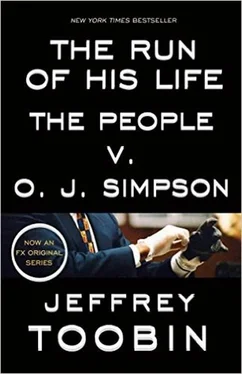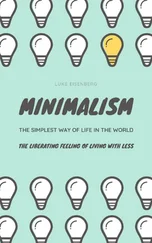Ito sent his clerk into the jury room to collect all the newspapers, and sure enough, she found a copy of The Wall Street Journal on which was scribbled, “They asked me about a juror writing a book.” Ito brought Chavarria back into his chambers. At first she denied writing a note, but when the judge confronted her with it, she broke down in tears and confessed that she had written it to Florio-Bunten. Jury service had obviously been a rough ordeal for Chavarria. Her skin had become blotchy and irritated, apparently because of the stress, and she had complained to Ito that Willie Cravin had stared at her and intimidated her several times. She read one self-help book after another- The Dance of Intimacy , then The Dance of Anger , and any number of others. Chavarria told Ito that she wrote the note to Florio-Bunten to remind her about an incident where another juror’s girlfriend had made a remark about writing a book. Ito then called Florio-Bunten into his chambers.
“Did another juror before you came in here write you a note about our discussions in here?”
“No,” said Florio-Bunten.
The judge then showed her the note. “Was that note shown to you, scribbled out by another juror?”
“No.”
“You’re sure?”
“I’m positive.”
“Any reason why two other jurors would say that note was shown to you?” Ito asked.
“I have no idea,” Florio-Bunten replied.
Everyone in the judge’s chambers-Ito, the defense lawyers, even Marcia Clark-thought Florio-Bunten was lying about seeing the note. Ito brought Florio-Bunten back another time and confronted her with the anonymous letter about the book. Florio-Bunten was indignant. “This is ridiculous,” she said. “I am here for one purpose, to be a juror.” Plainly disgusted at the entire line of questioning, Florio-Bunten finally said, “I mean, you know, Jesus. I want out. Just let me go. This is absolutely ridiculous.” With Marcia Clark’s consent, Ito did just that, dismissing Florio-Bunten for lying about the note from Chavarria, not specifically for the underlying accusations in the anonymous letter. Only four alternates remained.
The origin of the anonymous letter to Ito about Florio-Bunten remained (and remains) a considerable mystery. The author had a good deal of accurate inside knowledge, including Florio-Bunten’s approximate age, her husband’s medical condition, and the name of the jurors’ hotel. Yet Florio-Bunten and her husband continued to deny that they had ever discussed a book project with anyone, and she ultimately did not write a book. A survey of all Los Angeles-based book agents by 60 Minutes in March 1996 found no one who matched the self-description offered in the letter-which further corroborates Florio-Bunten’s claim that no such conversations took place. Members of the defense team, who had a motive to want Florio-Bunten removed, have categorically denied any role in the letter, and no evidence has surfaced tying them to it. In the end it was probably either a freelance effort by an insider to help Simpson’s cause, or part of a personal vendetta against Florio-Bunten.
In keeping with the obsessive media interest in the case, Florio-Bunten became a paid consultant to NBC’s Today show in the late stages of the trial, analyzing developments in the trial from her unique status as a former juror. As it turned out, the judge’s anonymous correspondent did O.J. Simpson a great favor, for Florio-Bunten said later that she definitely would have voted to convict him.

Both in the courtroom and in what passed for their private lives, several jurors showed signs of depression. One juror, Tracy Kennedy, tried to kill himself after he was dismissed, and another, Tracy Hampton, was rushed to the hospital with an apparent anxiety attack on the day after she left the jury. The jurors were further shaken when they learned that on July 19, one of the deputies who guarded them in the courtroom, Antranik Geuvjehizian, was murdered while trying to stop a burglary at a neighbor’s house. The isolation from friends and family, the endless waits as Ito listened to the lawyers haggle, and the mind-numbing testimony about arcane scientific matters all gave the jurors more than adequate reason to be miserable. Watching one after another of their colleagues summoned to Ito’s chambers and then dismissed-without being allowed so much as a goodbye to their fellow jurors or an explanation for the dismissal from the judge-added to the strain. Denied access to alcohol by the sheriffs, several jurors took solace in food. Family members, struggling to find some common ground with their increasingly estranged loved ones, began bringing gargantuan feasts to the hotel during visits-mostly cookies, cakes, and desserts of every description. The remaining jurors gained weight at a fantastic pace, which only compounded their despair.
Though Ito did not dismiss Farron Chavarria immediately after he caught her passing the note to Florio-Bunten, her days on the jury were numbered. On June 5, Ito decided to let her go because she had violated his order in tipping off her friend about the judge’s inquiry. Ito’s other action on that day came as more of a surprise. He dismissed Willie Cravin because “the Court has received numerous reports of personal conflict between [him] and other jurors,” including Cravin’s “deliberate and offensive physical contact and the threat of physical contact.” Yet Ito provided a less than overwhelming list of Cravin’s misdeeds-principally, a couple of purported shoves in the elevator and a pair of complaints from jurors that Cravin had stared at them.
In short, it appears that the judge, too, was monitoring the racial makeup of the jury. Upon reflection, Ito may have recognized that he had dismissed Florio-Bunten too precipitously, but having done so, he realized he had to dismiss Chavarria for essentially the same offense. That meant he was dropping consecutively two non-African-Americans. It is difficult not to conclude that Ito then pulled Cravin-a black man-as a sop to the prosecution. (Lawyers on both sides saw it this way.) The trial had become so swept up in race that, regrettably, the judge seemed also to be party to the bean-counting. The unexpected dismissal of Cravin sent Marcia Clark literally skipping with joy out of the courtroom.
The fourteen survivors-twelve jurors and now just two alternates-did not get much of a reward. After Chavarria and Cravin were ousted, they heard from Dr. Lakshmanan Sathyavagiswaran, the Los Angeles county coroner. He had not actually examined the two victims, but the pathologist who did, Irwin Golden, had made so many errors and testified so poorly at the preliminary hearing that the prosecution decided to call his boss instead. Dr. Lakshmanan, as he was addressed, couldn’t do much more than guess how the murders had occurred, but he did so in dramatic fashion.
Lakshmanan said that he believed a single killer with a single knife could have inflicted all the wounds on both victims. In his scenario, Nicole was first knocked out by a blow to the back of the head. The killer then leaned over her unconscious body, pulled her hair back, and slit her throat. Prosecutor Brian Kelberg had Lakshmanan demonstrate the movement by standing behind Kelberg and using a ruler to simulate a knife. Jurors and spectators alike recoiled at the grisly spectacle.
This method of execution had drawn prosecutors’ attention at an early stage in their investigation. Those with military experience recognized that the killing bore great similarity to the way U.S. Navy SEALs are trained to dispatch their adversaries. In the weeks before the murders, Simpson had been filming an NBC pilot, Frogman , where several ex-SEALs had served as technical advisers. Had O.J. been trained to kill this way? The prosecutors made a halfhearted effort to make the connection, but the technical advisers weren’t very cooperative and the issue faded amid the press of other business.
Читать дальше













